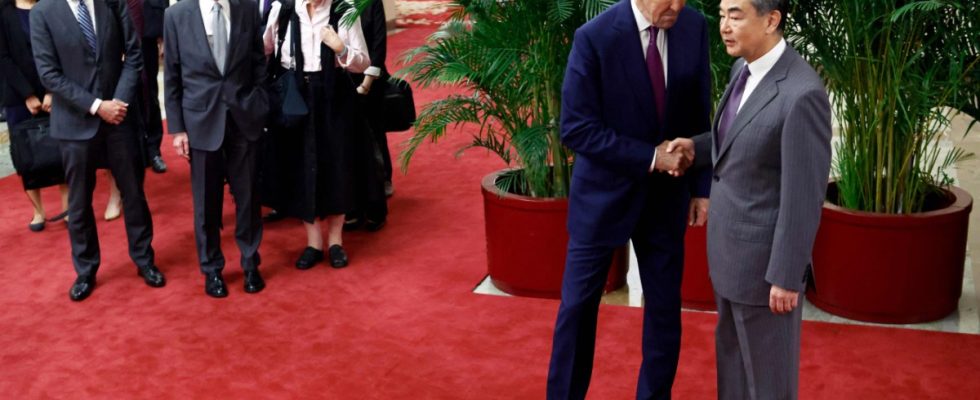When John Kerry started his journey home after four days in Beijing, he spoke of “new paths” that he wanted to take. Of productive, even warm-hearted conversations. But also from the realization that some problems still have to be solved in order to be able to take these new paths. The US government’s special climate envoy left with no concrete results. But with the plan that the USA and China now want to work closely together again on the subject of climate change. “We have agreed to meet again in the coming weeks,” said the 79-year-old. That alone fuels hope in the fight against the climate crisis.
Kerry’s visit was part of the Democratic US government’s rapprochement with China. Foreign Secretary Antony Blinken and Treasury Secretary Janet Yellen had previously been to Beijing. While their visits were also marked by discord, the prospects for an understanding on climate policy were better from the outset. This is also due to the good personal relationship between Kerry and the Chinese special climate envoy Xie Zhenhua, the two had already met during the climate conference in Egypt last November, despite the ice age between the countries.
The urgency can be read from the daily weather report
Cooperation between the great powers is also necessary, since the USA and China are the largest emitters. According to figures from 2021, China (30.9 percent) and the USA (13.5 percent) emit almost half of all greenhouse gases in the world. Without the two, nothing works in climate protection. Those involved could read the urgency from the daily weather report. No matter whether American, Chinese or European broadcasters: news about extreme heat waves dominated everywhere. Phoenix, Arizona: almost 47 degrees Celsius, record. Rome, Italy: almost 43 degrees, record. Sanbao, China: more than 52 degrees, record. Global warming delivered new extremes in the past week.
Despite all the differences, the Americans and Chinese have long cooperated on climate protection. In 2021, they surprisingly agreed on increased cooperation and committed each other to action. But above all the dispute over Taiwan stopped the talks.
“We expect that a regular exchange between the two largest emitters will take place again,” said Lutz Weischer, China expert of the environmental organization Germanwatch, the SZ. This alone is helpful and makes it easier to get results at the upcoming climate conference in Dubai at the beginning of December.
The signals from Beijing during the Kerry days are mixed. On the one hand, it is considered a success that the 79-year-old not only met his colleague Xie Zhenhua, but also Prime Minister Li Qiang, Vice President Han Zheng and top diplomat Wang Yi. But there are still no answers to important questions.
China wants to meet targets – but above all not to be interfered with
For example, it is unclear whether China will join the international pact to reduce methane emissions, a very effective greenhouse gas. Here, too, China is the largest polluter. To reduce CO₂ emissions, China would have to stop building new coal-fired power plants, but the ruling Communist Party is not ready for that just yet. Head of state Xi Jinping emphasized on Tuesday that the goals that have been in force so far will be tackled with determination. China wants to reach its peak of greenhouse gas emissions before 2030 and become climate neutral before 2060. But Xi insisted on a kind of climate autonomy: “The way, the method, the pace and the intensity to achieve this goal should and must be determined by ourselves and will never be influenced by others.”
A thorny issue is the fact that China is still in the developing country category in international climate diplomacy and does not participate in funding the funds for poorer countries in the Global South. Western industrialized countries are to make around 100 billion US dollars available annually so that developing countries can reduce their emissions and better protect themselves against storms, droughts or floods. The next issue is compensation payments for “damage and losses” in poorer countries. The United States and Germany are increasingly vehemently demanding that the largest current emitter be included in the group of payers – China has blocked so far.
“This issue requires patient diplomacy on the part of the United States and the most important European countries,” Li Shuo, political advisor to the environmental organization Greenpeace in East Asia, told the SZ. He sees a “major geopolitical problem” here that John Kerry’s visit was unable to solve. Because alongside China, the now rich Arab countries are also hiding behind the label “developing country”. And among the Western industrialized countries, it is above all the USA that provides far too little money compared to its size and the amount of emissions.
China and the US must now prove in the coming meetings that they are serious about the transformation away from fossil fuels, said Kerry. The transition to renewable energies and climate-neutral gases must be accelerated.

